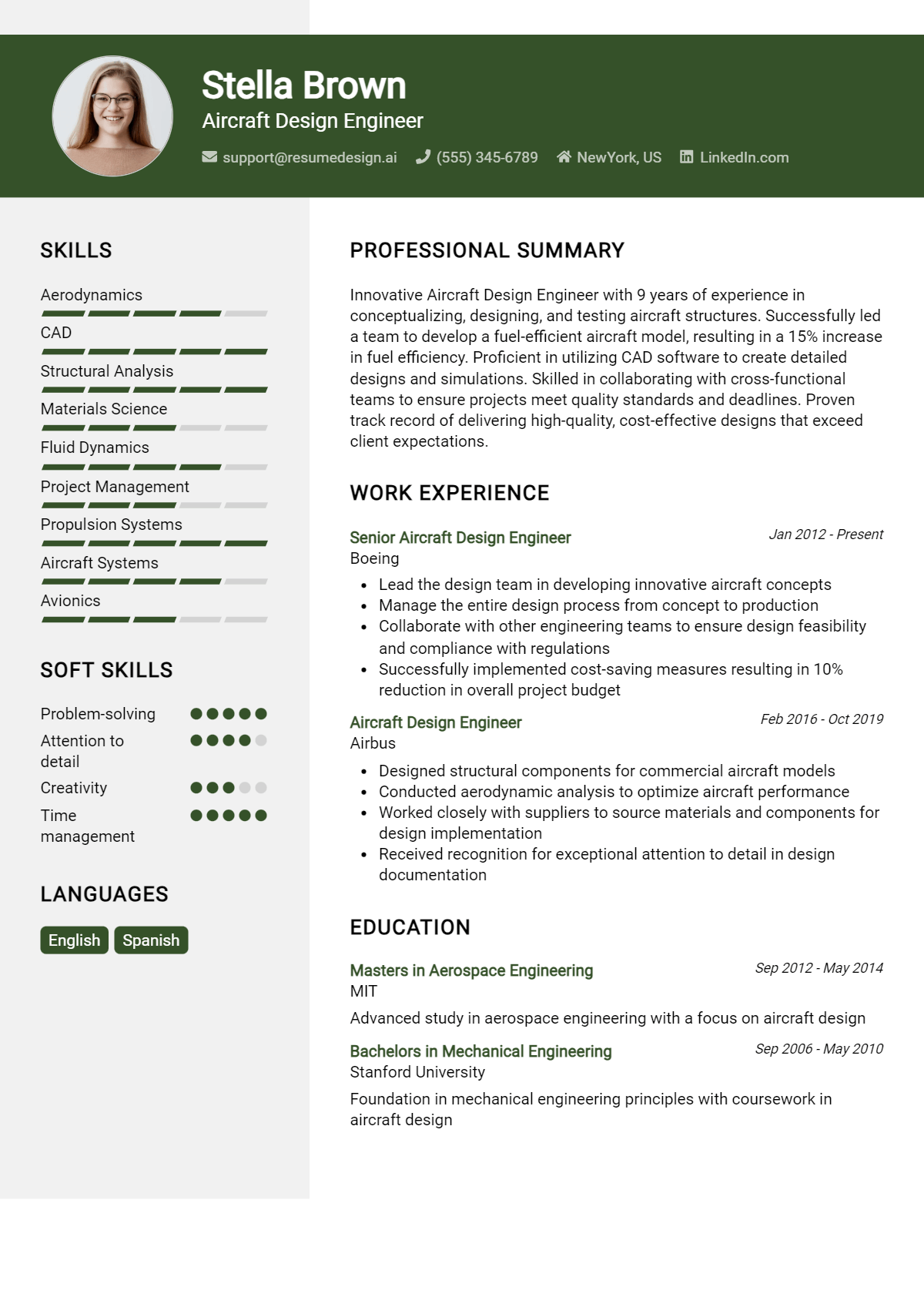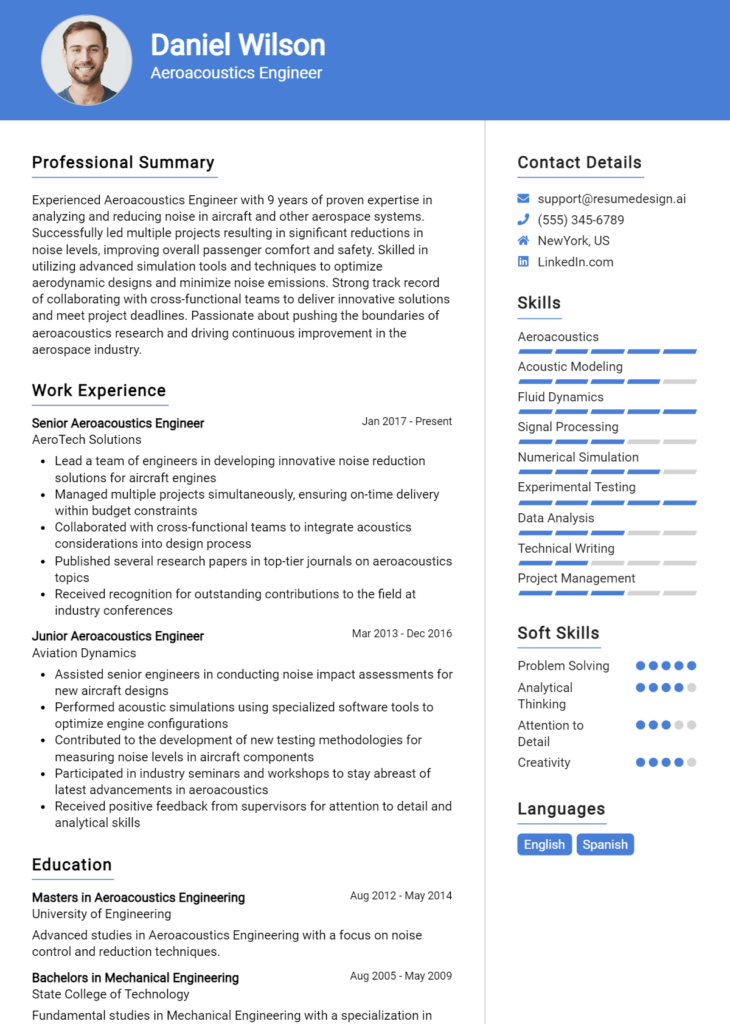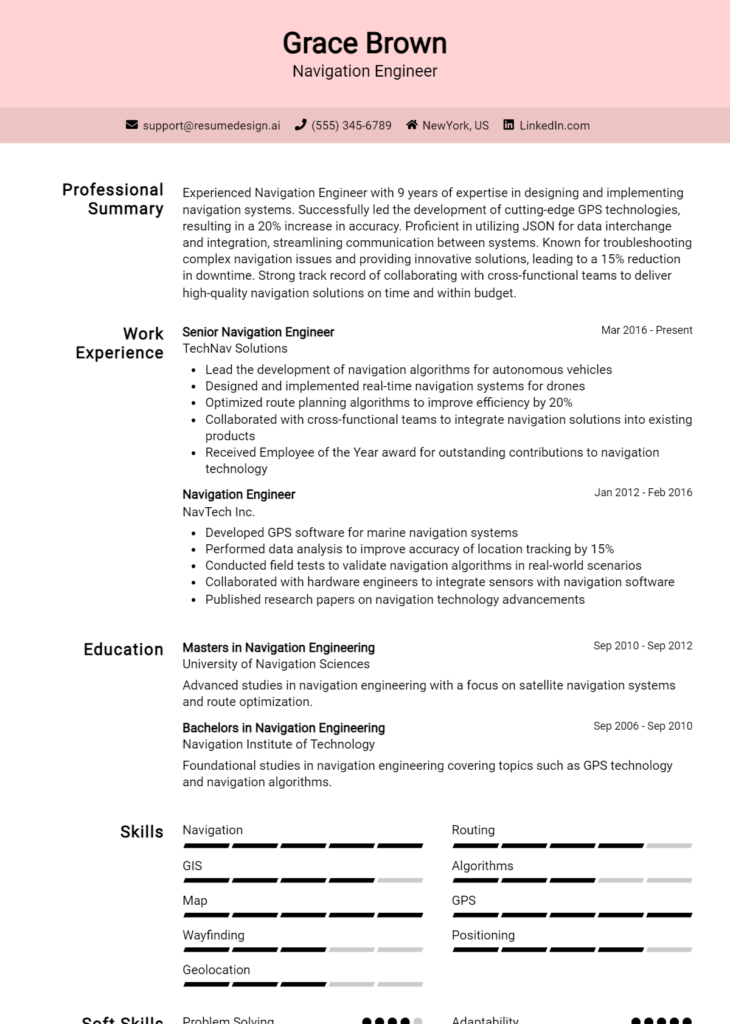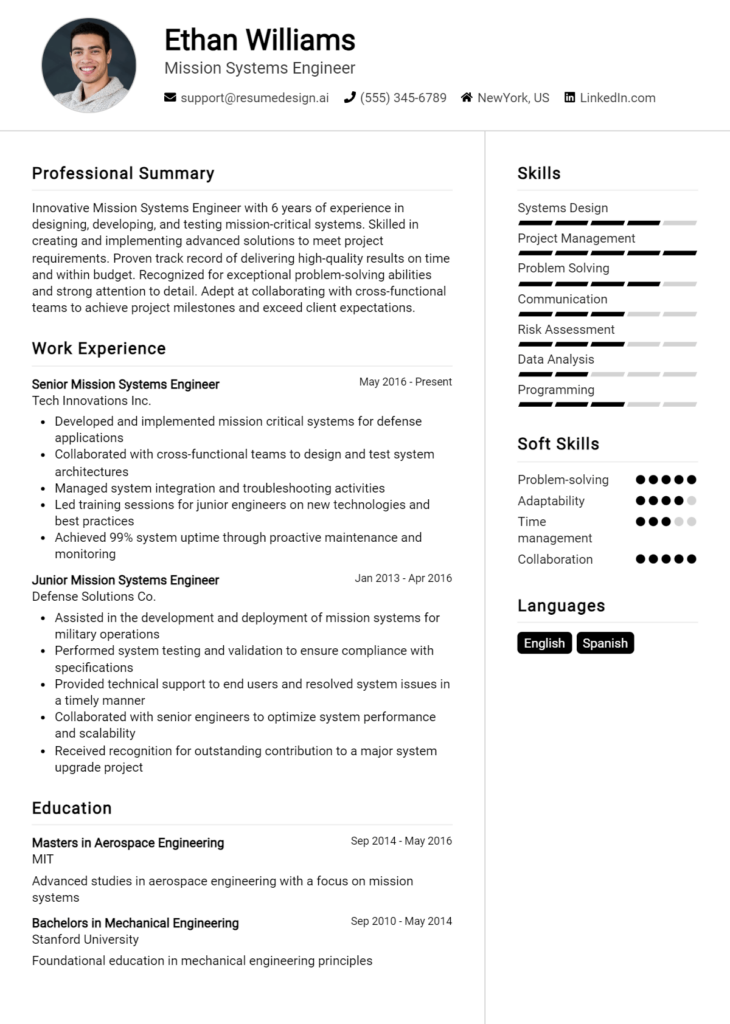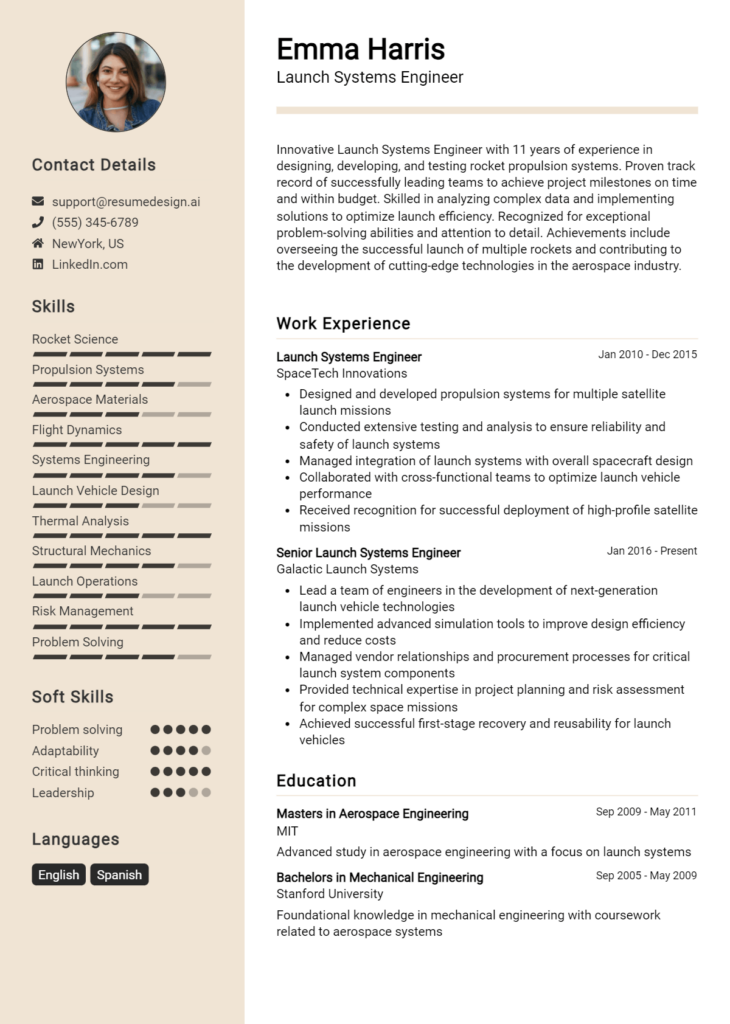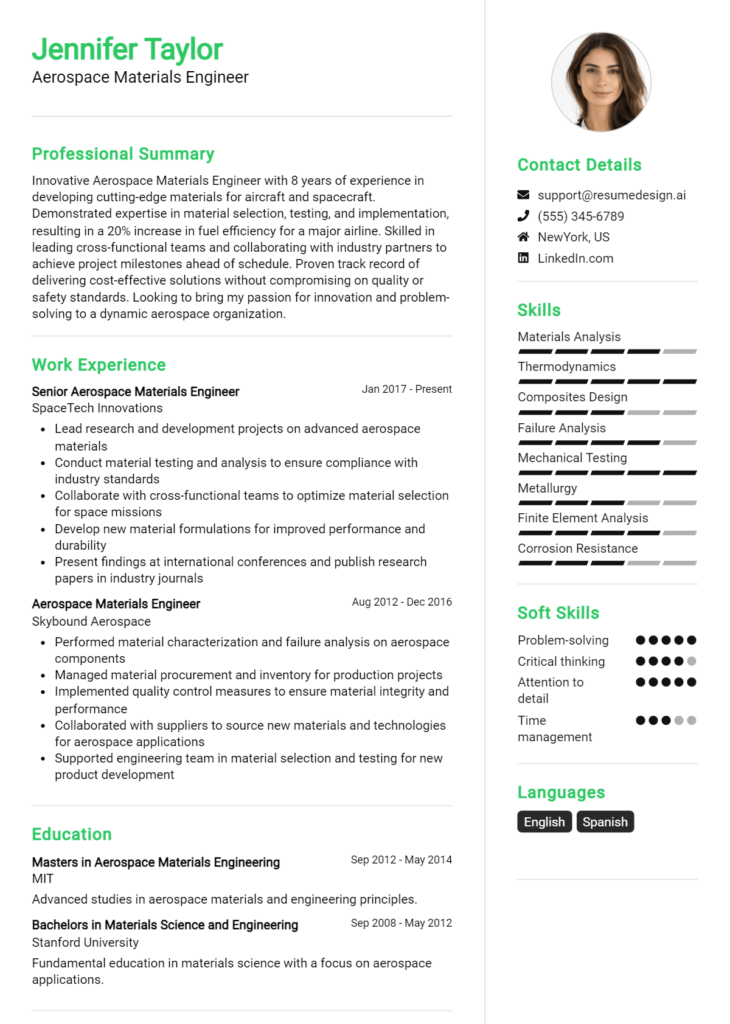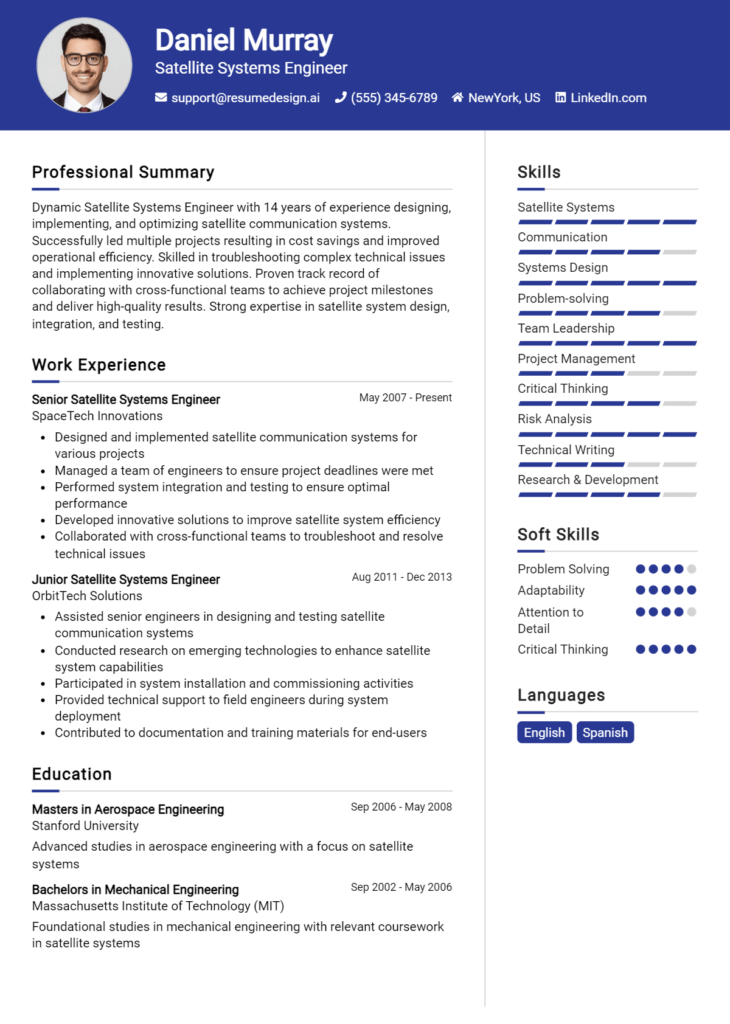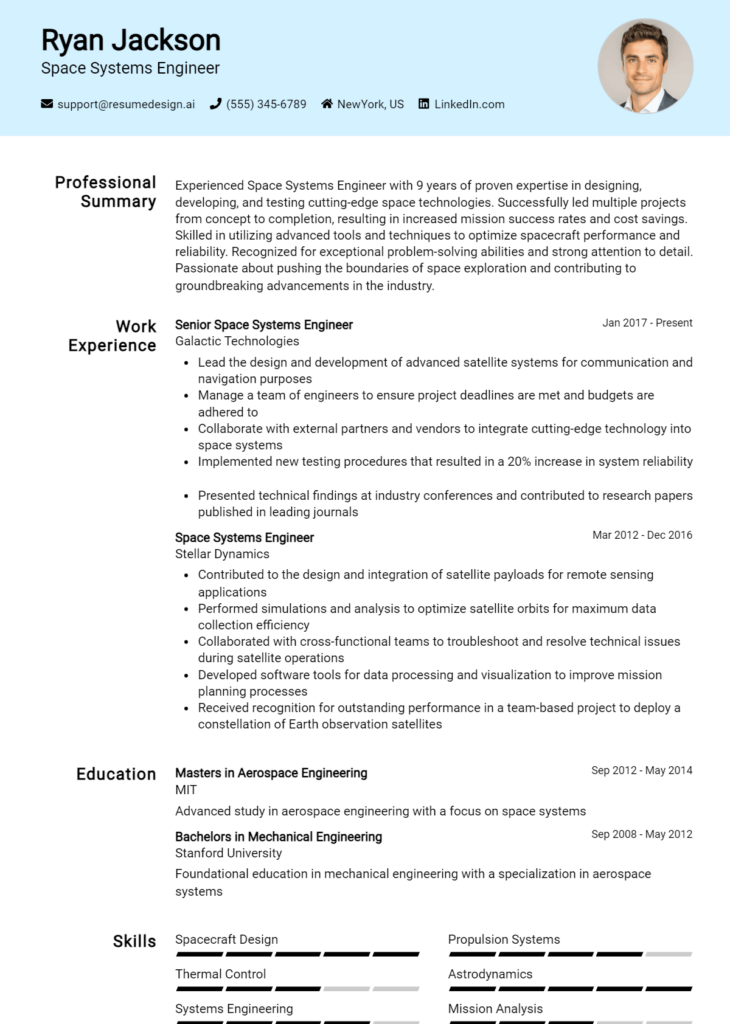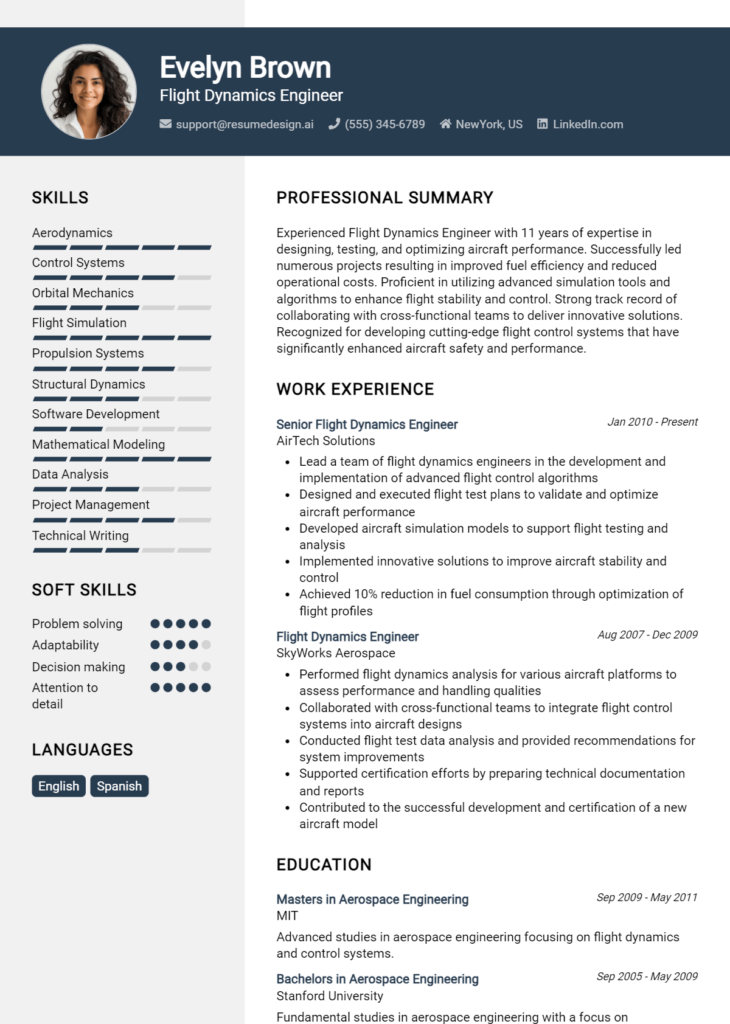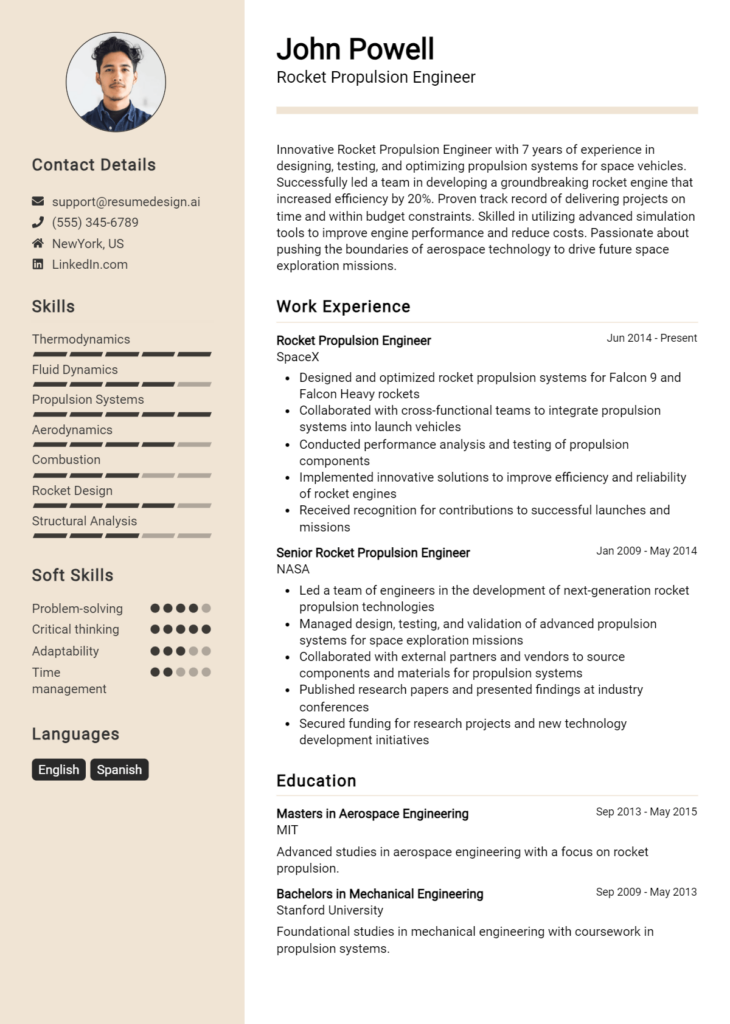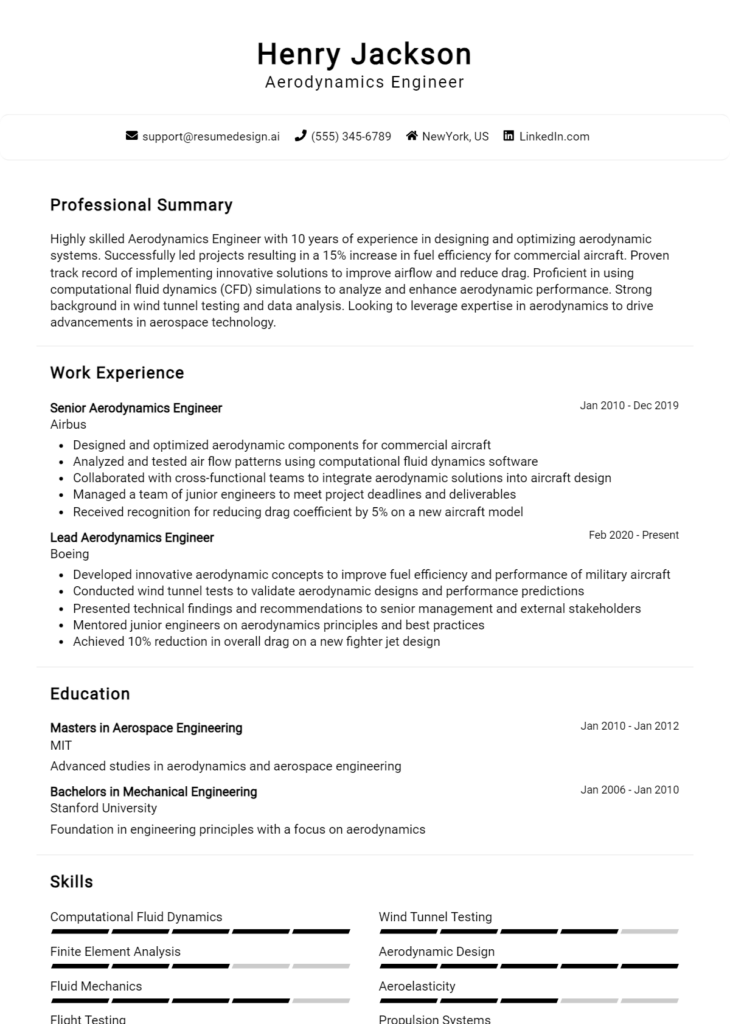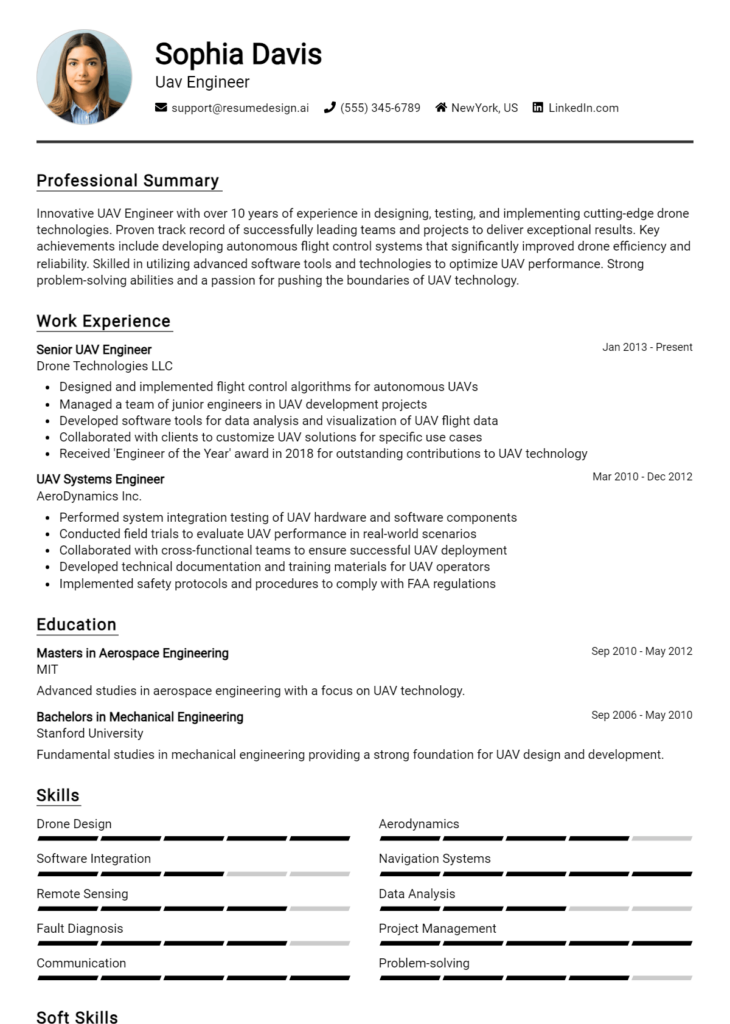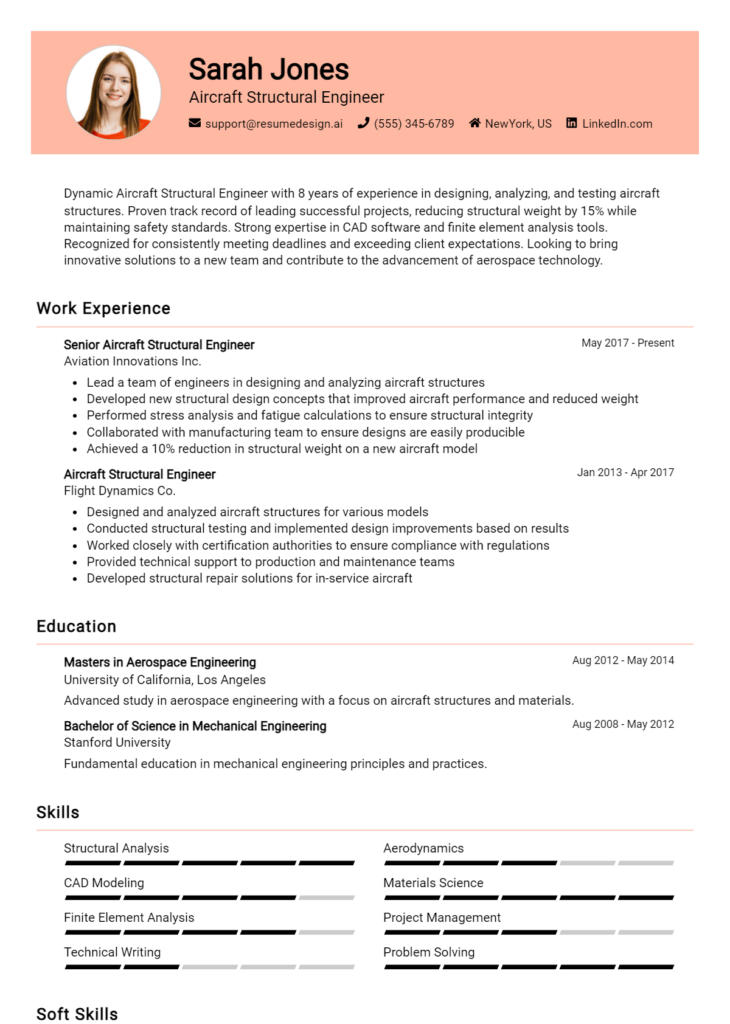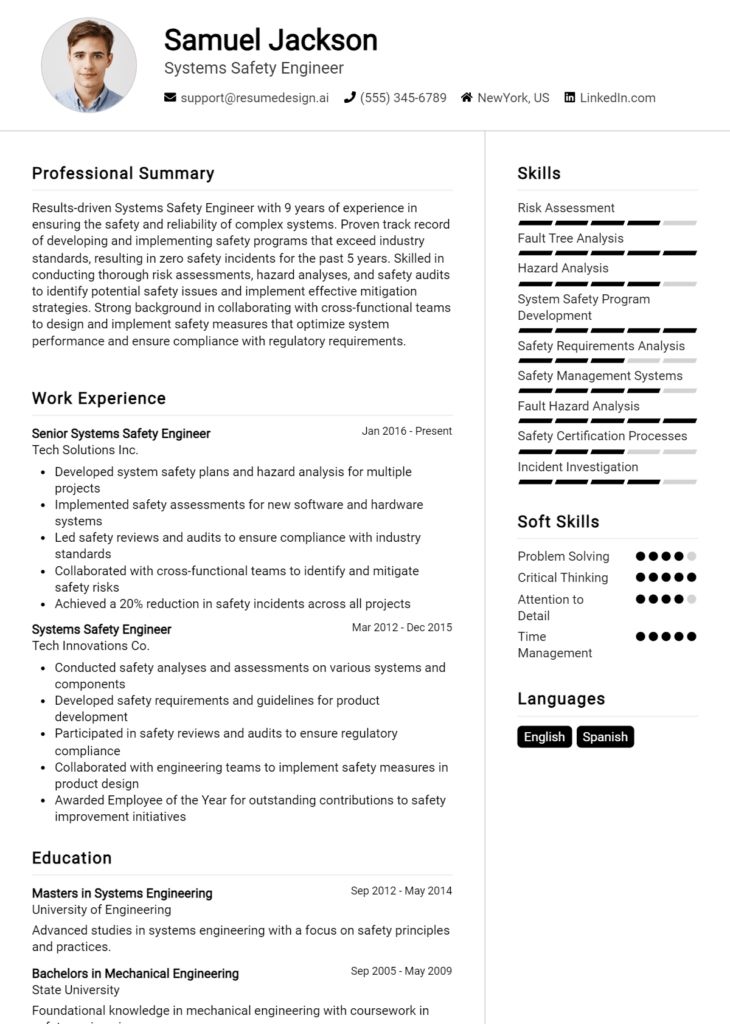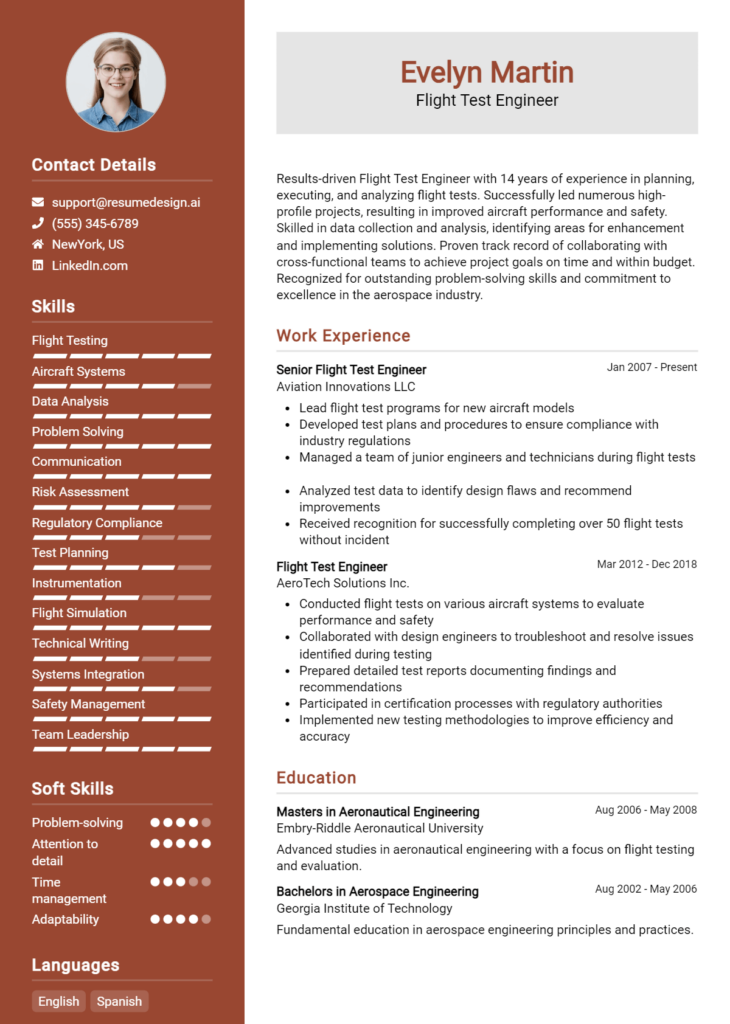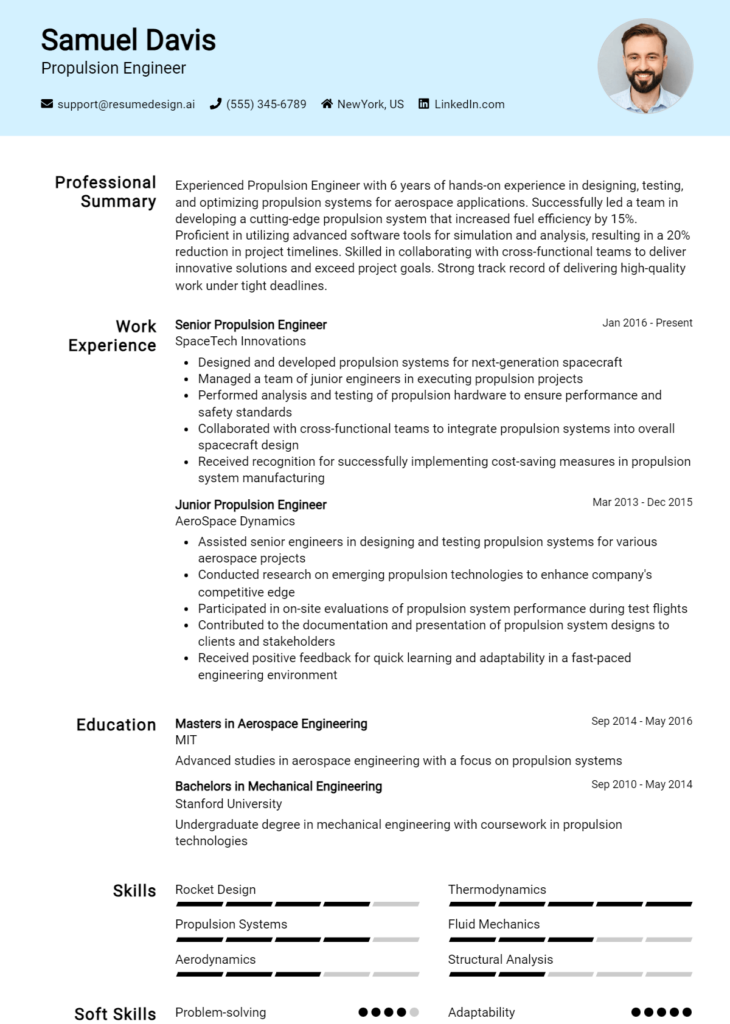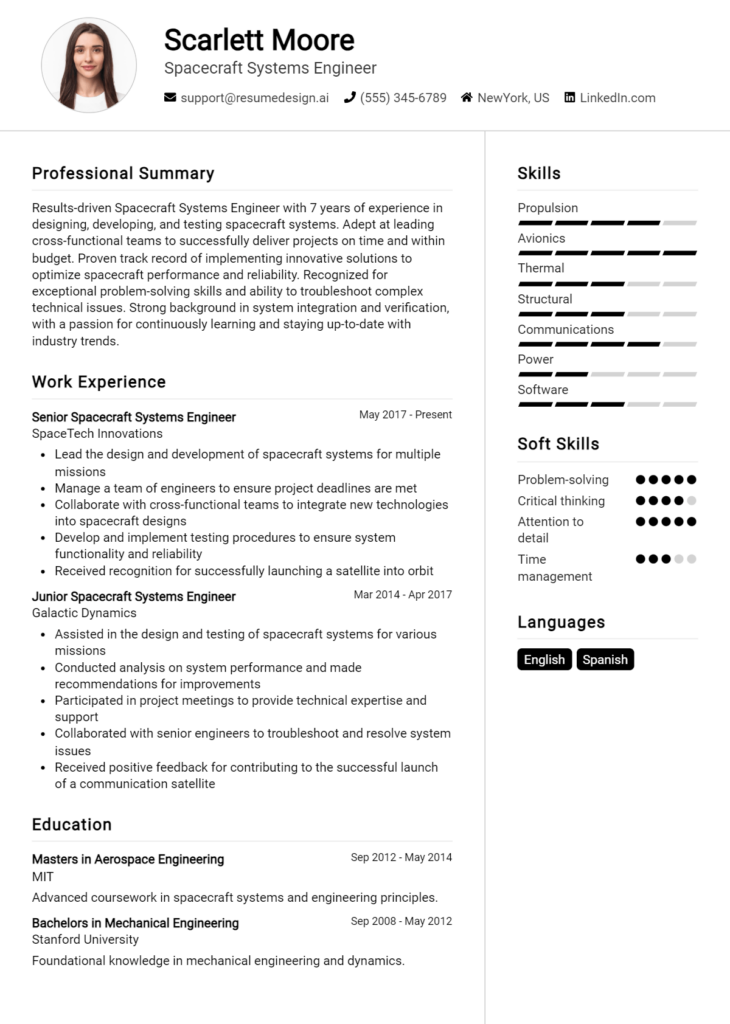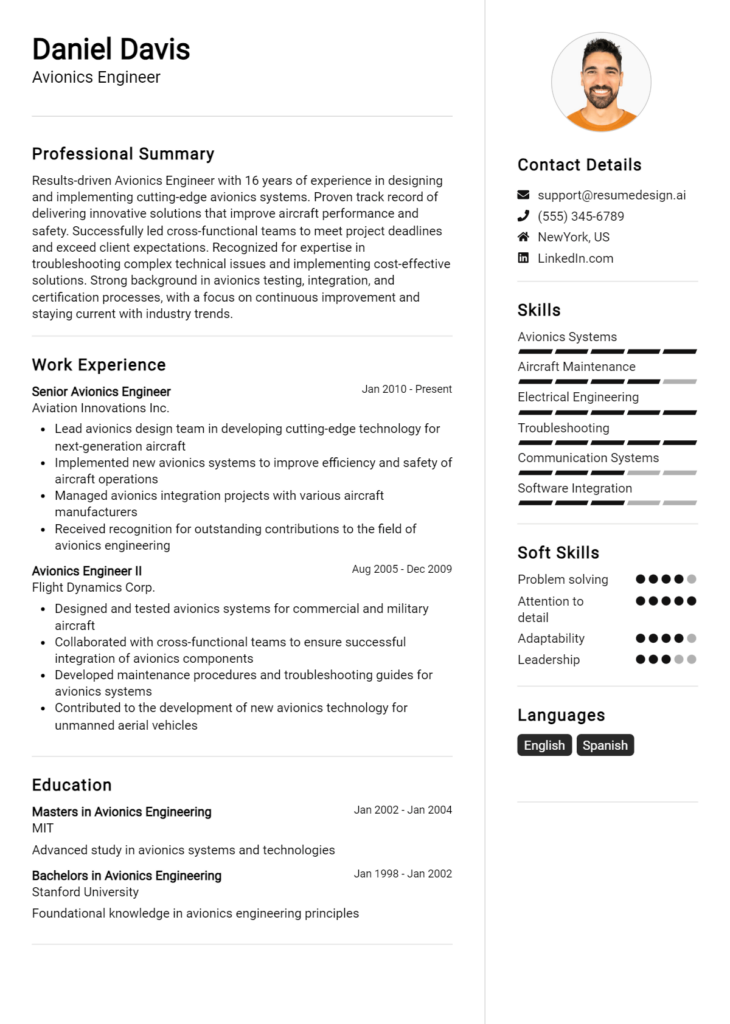Aircraft Design Engineer Core Responsibilities
An Aircraft Design Engineer is responsible for the conceptualization, design, and development of aircraft structures and systems. This role requires a strong blend of technical knowledge, operational understanding, and problem-solving abilities, as it bridges various departments including engineering, manufacturing, and quality assurance. Successful engineers must effectively collaborate with multidisciplinary teams to ensure designs meet safety and performance standards. A well-crafted resume can highlight these essential skills, showcasing the engineer's contribution to the organization's overarching goals.
Common Responsibilities Listed on Aircraft Design Engineer Resume
- Conducting aerodynamic analysis and simulations to optimize aircraft performance.
- Developing detailed design specifications and documentation for aircraft components.
- Collaborating with cross-functional teams to integrate systems and subsystems.
- Performing stress and structural analysis to ensure design integrity.
- Participating in design reviews and presenting findings to stakeholders.
- Managing project timelines and deliverables to meet production schedules.
- Ensuring compliance with aviation regulations and safety standards.
- Utilizing CAD software for 3D modeling and design visualization.
- Conducting testing and validation of prototypes and final products.
- Identifying and resolving design-related issues during the development process.
- Documenting design changes and maintaining accurate project records.
- Staying updated on industry trends and technological advancements.
High-Level Resume Tips for Aircraft Design Engineer Professionals
In the competitive field of aircraft design engineering, a well-crafted resume is your ticket to making a lasting first impression on potential employers. As the first point of contact, your resume needs to effectively showcase not only your technical skills but also your achievements and contributions to previous projects. It serves as a marketing tool that highlights your qualifications and sets you apart from other candidates. This guide will provide practical and actionable resume tips specifically tailored for Aircraft Design Engineer professionals, helping you to present your unique value in a clear and compelling manner.
Top Resume Tips for Aircraft Design Engineer Professionals
- Tailor your resume to the job description by using relevant keywords and phrases that align with the specific role.
- Highlight your engineering degree and any specialized certifications, ensuring they are prominently featured at the top of your resume.
- Showcase relevant experience by detailing your contributions to aircraft design projects, including specific roles and responsibilities.
- Quantify your achievements by using metrics such as project completion times, cost savings, or performance improvements to demonstrate your impact.
- Include industry-specific skills such as proficiency in CAD software, knowledge of aerodynamics, or experience with regulatory compliance.
- Utilize a clean and professional layout that enhances readability and allows key information to stand out.
- Incorporate a summary statement that succinctly outlines your key qualifications and career goals at the beginning of your resume.
- List relevant internships or co-op experiences that provide practical exposure to aircraft design and engineering principles.
- Keep your resume concise, ideally one page, ensuring that every word adds value and relevance to your application.
By implementing these tips, you can significantly enhance the effectiveness of your resume and increase your chances of landing a job in the Aircraft Design Engineer field. A polished and well-organized resume that effectively communicates your skills and experiences will not only capture the attention of hiring managers but also position you as a strong candidate in this competitive industry.
Why Resume Headlines & Titles are Important for Aircraft Design Engineer
In the competitive field of aircraft design engineering, a well-crafted resume headline or title serves as a powerful first impression. It acts as a succinct summary of a candidate's qualifications and expertise, allowing hiring managers to quickly gauge the applicant's suitability for the role. A strong headline can effectively capture attention and highlight key strengths in a single impactful phrase, making it essential for candidates to convey their specific skills and experiences relevant to the position they are applying for. By keeping the headline concise and directly aligned with the job description, candidates can increase their chances of standing out in a crowded applicant pool.
Best Practices for Crafting Resume Headlines for Aircraft Design Engineer
- Be concise: Aim for a headline that is clear and to the point.
- Use relevant keywords: Incorporate industry-specific terms that align with the job description.
- Highlight key skills: Focus on the most important skills or experiences that make you a strong candidate.
- Tailor for each application: Customize the headline to reflect the specific requirements of each job posting.
- Showcase achievements: If applicable, include noteworthy accomplishments that demonstrate your expertise.
- Maintain professionalism: Use formal language and avoid informal phrasing.
- Be specific: Rather than using broad terms, specify the area of expertise or type of aircraft design.
- Consider your audience: Think about what hiring managers in the aerospace industry are looking for.
Example Resume Headlines for Aircraft Design Engineer
Strong Resume Headlines
Innovative Aircraft Design Engineer with 7+ Years of Experience in Aerodynamics and Structural Analysis
Results-Driven Aerospace Engineer Specializing in Lightweight Composite Materials and Optimization Techniques
Award-Winning Aircraft Designer with Proven Track Record in Reducing Production Costs by 20%
Weak Resume Headlines
Engineer Looking for Opportunities
Aerospace Professional
The strong headlines are effective because they immediately convey specific qualifications, experiences, and achievements relevant to the aircraft design engineering role. They use precise language that resonates with hiring managers and showcases the candidate's value. Conversely, the weak headlines fail to impress due to their vagueness and lack of detail, providing no compelling reason for the hiring manager to consider the applicant further. A strong, focused headline sets the stage for a successful resume, while weak headlines risk being overlooked entirely.
Writing an Exceptional Aircraft Design Engineer Resume Summary
A well-crafted resume summary is a crucial element for an Aircraft Design Engineer, as it serves as the first impression for hiring managers. A strong summary succinctly conveys the candidate’s key skills, relevant experience, and significant accomplishments, effectively capturing the attention of potential employers. It should be concise yet impactful, tailored to the specific job description, and aligned with the requirements of the role. By quickly highlighting what makes a candidate stand out, an exceptional resume summary can significantly enhance the chances of landing an interview.
Best Practices for Writing a Aircraft Design Engineer Resume Summary
- Quantify Achievements: Use numbers and metrics to demonstrate the impact of your work, such as cost savings or efficiency improvements.
- Focus on Skills: Highlight both technical and soft skills that are relevant to aircraft design, such as CAD proficiency, teamwork, and problem-solving.
- Tailor to the Job Description: Customize your summary to reflect the specific requirements and keywords mentioned in the job posting.
- Be Concise: Aim for 2-4 sentences that deliver a powerful message without overwhelming the reader.
- Showcase Relevant Experience: Mention specific projects or areas of expertise that align with the role you are applying for.
- Use Strong Action Verbs: Begin sentences with dynamic verbs to convey a sense of proactivity and impact.
- Reflect Industry Knowledge: Demonstrate familiarity with current trends and technologies in aircraft design to show you’re engaged in the field.
- Avoid Jargon: Keep the language clear and straightforward to ensure that your summary is accessible to a wide audience.
Example Aircraft Design Engineer Resume Summaries
Strong Resume Summaries
Results-driven Aircraft Design Engineer with over 7 years of experience in developing innovative aircraft systems, leading to a 15% reduction in manufacturing costs. Proficient in CAD software and structural analysis, with a proven track record of delivering projects on time and within budget.
Detail-oriented Aircraft Design Engineer with expertise in aerodynamics and materials science. Successfully led a team project that achieved a 20% increase in fuel efficiency for a commercial aircraft prototype, contributing to a $2 million contract.
Dynamic Aircraft Design Engineer with a strong background in composite materials and stress analysis. Designed and implemented a lightweight wing structure that decreased overall aircraft weight by 12%, enhancing performance metrics significantly.
Innovative Aircraft Design Engineer with 5 years of experience in the aerospace industry, focusing on avionics integration. Spearheaded a project that improved navigation system accuracy by 30%, enhancing safety and operational efficiency.
Weak Resume Summaries
Experienced engineer looking for a position in aircraft design. Good at working in teams.
Aircraft Design Engineer with a background in various projects. Seeking to leverage skills in a new role.
The strong resume summaries provided are effective because they include quantifiable results, specific skills, and direct relevance to the Aircraft Design Engineer role. They showcase the candidate's ability to contribute positively to a potential employer. In contrast, the weak summaries are vague and lack detail, failing to provide any measurable achievements or relevant skills, making them less impactful and less likely to attract the attention of hiring managers.
Work Experience Section for Aircraft Design Engineer Resume
The work experience section of an Aircraft Design Engineer resume serves as a critical platform for candidates to demonstrate their technical skills, project management capabilities, and commitment to delivering high-quality aerospace products. This section not only reflects the candidate's hands-on experience but also illustrates their ability to collaborate with teams and drive projects to successful completion. By quantifying achievements and aligning experiences with industry standards, candidates can effectively showcase their value to potential employers, making this section a pivotal part of the overall resume.
Best Practices for Aircraft Design Engineer Work Experience
- Highlight specific technical skills relevant to aircraft design, such as CAD software proficiency, materials science knowledge, or regulatory compliance expertise.
- Quantify achievements with data, such as percentages, cost savings, or project timelines, to illustrate impact and results.
- Emphasize collaboration by detailing experiences in cross-functional teams, showcasing communication skills and teamwork.
- Focus on leadership roles, describing how you guided teams or projects and the outcomes of those efforts.
- Use action verbs to convey a sense of initiative and responsibility in your roles.
- Align experiences with industry standards and requirements to demonstrate familiarity with best practices and regulations.
- Include notable projects or contributions to significant milestones in aircraft design or production.
- Tailor your experiences to the specific job description, ensuring relevance to the role you are applying for.
Example Work Experiences for Aircraft Design Engineer
Strong Experiences
- Led a team of 10 engineers in the design of a fuel-efficient aircraft wing, resulting in a 20% reduction in drag and a 15% improvement in fuel efficiency compared to previous models.
- Successfully managed a project that achieved FAA certification for a new avionics system, enhancing flight safety and operational reliability.
- Developed innovative composite material solutions that reduced aircraft weight by 10%, contributing to overall cost savings of $1.5 million in production expenses.
- Collaborated with cross-disciplinary teams to implement a new design process that shortened project timelines by 25%, allowing for faster market entry.
Weak Experiences
- Worked on various projects related to aircraft design.
- Participated in meetings about aircraft efficiency.
- Assisted in the development of engineering documentation.
- Helped with general tasks in the design department.
The examples of strong experiences are considered effective because they are specific, quantifiable, and demonstrate clear outcomes, showcasing the candidate's technical leadership and ability to collaborate successfully. In contrast, the weak experiences lack detail and impact, failing to communicate the candidate's actual contributions or achievements in a meaningful way. The strong examples reflect a proactive approach and measurable results, while the weak examples come off as vague and unimpressive, ultimately not adding value to the resume.
Education and Certifications Section for Aircraft Design Engineer Resume
The education and certifications section of an Aircraft Design Engineer resume is crucial for showcasing the candidate's academic background and commitment to professional development. This section not only highlights the educational qualifications necessary for the role but also demonstrates the candidate's pursuit of industry-relevant certifications and specialized training. By providing details of relevant coursework, certifications, and ongoing learning efforts, candidates can significantly enhance their credibility and showcase their alignment with the specific demands of the aircraft design field.
Best Practices for Aircraft Design Engineer Education and Certifications
- Include degrees in aerospace engineering, mechanical engineering, or related fields to establish a solid educational foundation.
- List relevant certifications, such as Certified Aerospace Technician (CAT) or Project Management Professional (PMP), to demonstrate specialized skills.
- Provide details on major projects or thesis work that directly relates to aircraft design, showcasing practical knowledge.
- Highlight any coursework in aerodynamics, propulsion, materials science, or computer-aided design (CAD) tools.
- Include advanced degrees, such as a Master's or Ph.D. in a relevant discipline, to set yourself apart from other candidates.
- Keep the information concise and relevant, focusing on qualifications that match the job requirements.
- Update this section regularly to reflect new certifications or completed training programs that enhance your skill set.
- Consider mentioning participation in workshops, seminars, or industry conferences to illustrate continuous learning and engagement with the field.
Example Education and Certifications for Aircraft Design Engineer
Strong Examples
- Bachelor of Science in Aerospace Engineering, University of Michigan, 2018
- Certified Aerospace Technician (CAT), National Institute for Certification in Engineering Technologies, 2021
- Master’s in Mechanical Engineering with a focus on Aircraft Design, Stanford University, 2020
- Completed coursework in Advanced Aerodynamics and Aircraft Structures, 2019
Weak Examples
- Bachelor of Arts in History, University of California, 2015
- Certification in Basic Computer Skills, 2019
- High School Diploma, 2010
- Outdated certification in Aviation Management, 2005
The strong examples are considered effective because they include relevant degrees and certifications that align directly with the responsibilities of an Aircraft Design Engineer. They demonstrate a solid educational background in aerospace-related fields and ongoing professional development. In contrast, the weak examples highlight qualifications that are either unrelated to the aircraft design engineering field or outdated, making them less impactful in the context of a targeted resume.
Top Skills & Keywords for Aircraft Design Engineer Resume
As an Aircraft Design Engineer, possessing the right skills is crucial to not only secure a position but also to excel in this competitive field. The aerospace industry demands a blend of technical expertise and interpersonal abilities to navigate complex design processes, collaborate with multidisciplinary teams, and innovate solutions to challenging engineering problems. A well-crafted resume that highlights both hard and soft skills can significantly enhance your prospects, showcasing your capability to contribute to advanced aircraft design projects. For a comprehensive understanding of what skills can elevate your resume, refer to this skills resource.
Top Hard & Soft Skills for Aircraft Design Engineer
Soft Skills
- Problem-solving
- Communication
- Team collaboration
- Adaptability
- Attention to detail
- Time management
- Creativity
- Critical thinking
- Leadership
- Project management
- Interpersonal skills
- Conflict resolution
- Mentorship
Hard Skills
- Proficiency in CAD software (e.g., CATIA, SolidWorks)
- Knowledge of aerodynamics principles
- Understanding of materials science
- Experience with finite element analysis (FEA)
- Familiarity with computational fluid dynamics (CFD)
- Knowledge of FAA regulations and certification processes
- Proficient in systems engineering
- Experience with prototype testing and validation
- Ability to conduct structural analysis
- Familiarity with aircraft systems design
- Programming skills (e.g., MATLAB, Python)
- Knowledge of manufacturing processes
- Understanding of avionics systems
- Experience in project lifecycle management
- Proficient with simulation software
- Strong mathematical skills
- Knowledge of environmental and safety regulations
By emphasizing these essential skills in your resume and aligning them with your work experience, you can present yourself as a well-rounded candidate ready to tackle the challenges of aircraft design and engineering.
Stand Out with a Winning Aircraft Design Engineer Cover Letter
As a dedicated Aircraft Design Engineer with over five years of experience in the aerospace industry, I am excited to apply for the position at [Company Name]. My background in advanced aerodynamic modeling, structural analysis, and propulsion systems design has equipped me with the skills necessary to contribute effectively to your team. I am particularly impressed by [Company Name]'s commitment to innovation and sustainability in aviation, and I am eager to bring my expertise to help advance your projects.
In my previous role at [Previous Company Name], I successfully led a multidisciplinary team in the design and optimization of a regional aircraft that achieved a 15% reduction in fuel consumption through innovative aerodynamic improvements. I utilized tools such as CATIA and ANSYS to create detailed 3D models and conduct simulations, ensuring the aircraft met all performance and safety standards. My hands-on experience in prototype testing and collaboration with cross-functional teams has honed my ability to translate complex engineering concepts into practical solutions that meet client specifications and regulatory requirements.
I am particularly passionate about integrating cutting-edge technologies into aircraft design, including the use of composite materials and hybrid propulsion systems. My commitment to continuous learning drives me to stay updated on the latest industry trends and advancements. I believe my proactive approach to problem-solving and my ability to work under pressure will align well with the dynamic environment at [Company Name]. I look forward to the opportunity to further discuss how I can contribute to your innovative projects and help shape the future of aviation.
Thank you for considering my application. I am eager to bring my skills and passion for aircraft design to [Company Name] and contribute to your mission of delivering exceptional aerospace solutions. I would welcome the chance to discuss my qualifications in more detail and explore how I can add value to your esteemed team.
Common Mistakes to Avoid in a Aircraft Design Engineer Resume
When crafting a resume for the position of an Aircraft Design Engineer, it's crucial to present your skills and experiences in a way that highlights your qualifications. However, many candidates make common mistakes that can detract from their overall appeal. By avoiding these pitfalls, you can create a more effective resume that stands out to potential employers. Here are some common mistakes to avoid:
Generic Objective Statement: Using a vague objective statement can make your resume feel impersonal. Tailor your objective to reflect your specific career goals and how they align with the prospective employer's needs.
Overloading with Technical Jargon: While technical skills are vital in aircraft design, excessive jargon can alienate hiring managers who may not be familiar with every term. Strive for clarity and balance between technical language and layman's terms.
Neglecting Soft Skills: Focusing solely on technical expertise may overlook the importance of soft skills such as teamwork, communication, and problem-solving. Highlighting these skills can illustrate your ability to collaborate effectively within a team.
Inconsistent Formatting: A resume with inconsistent fonts, sizes, and bullet points can be visually unappealing and difficult to read. Maintain a clean and uniform format throughout to enhance readability.
Failing to Quantify Achievements: Merely listing responsibilities without quantifying your achievements can diminish your impact. Use numbers and metrics to demonstrate how your contributions led to specific outcomes.
Ignoring Tailoring for Each Application: Sending out the same resume for multiple job applications can be detrimental. Tailor your resume for each position by emphasizing relevant experiences and skills that match the job description.
Omitting Relevant Projects or Certifications: Failing to include key projects or certifications relevant to aircraft design can weaken your application. Ensure you highlight any significant projects, internships, or certifications that showcase your expertise.
Lengthy Resumes: A resume that is too long can overwhelm hiring managers. Aim for a concise format, ideally one to two pages, focusing on the most relevant information that showcases your qualifications effectively.
Conclusion
As an Aircraft Design Engineer, your role is crucial in the development and innovation of aircraft systems and components. Throughout this article, we examined the fundamental skills required for success in this field, including proficiency in CAD software, a strong understanding of aerodynamics, and a solid foundation in materials science. We also highlighted the importance of teamwork and communication skills, given the collaborative nature of aircraft design projects.
The demand for skilled Aircraft Design Engineers is steadily increasing as the aviation industry continues to evolve, driven by advancements in technology and a focus on sustainability. Therefore, ensuring that your resume effectively showcases your experience, skills, and accomplishments is essential for standing out in the competitive job market.
Now is the perfect time to review and update your Aircraft Design Engineer resume. Make sure it reflects your expertise and aligns with the latest industry standards. Utilize the available resources to enhance your application materials. Explore our resume templates, use the resume builder for a streamlined approach, check out resume examples for inspiration, and consider our cover letter templates to complement your resume.
Take the next step in your career by refining your resume today!

